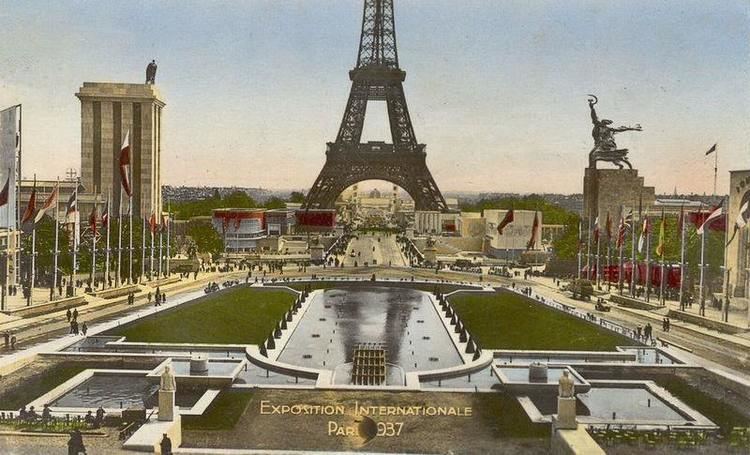BIE-class Universal exposition Visitors 31,040,955 | ||
 | ||
Category Second category General Exposition Name Exposition Internationale des Arts et des Techniques appliqués à la vie moderne Area 101 hectares (250 acres) | ||
The Exposition Internationale des Arts et Techniques dans la Vie Moderne (International Exposition of Art and Technology in Modern Life) was held from 25 May to 25 November 1937 in Paris, France. Both the Musée de l'Homme and the Palais de Tokyo, which houses the Musée d'Art Moderne de la Ville de Paris, were created for this exhibition.
Contents
Exhibitions
At first the centerpiece of the exposition was to be a 2,300-foot (700 m) tower ("Phare du Monde") which was to have a spiraling road to a parking garage located at the top and a hotel and restaurant located above that. The idea was abandoned as far too expensive.
Fitting in the architectural master-plan of the master architect Jacques Gréber at the foot of the Eiffel Tower, and inspired by the shape of a grain elevator, the Canadian pavilion included Joseph-Émile Brunet's 28-foot sculpture of a buffalo (1937). Paintings by Brunet, sculpted panels on the outside of the structure, and several thematic stands inside the Canadian pavilion depicted aspects of Canadian culture.
The Spanish pavilion attracted attention as the exposition took place during the Spanish Civil War. The Spanish pavilion was built by the Spanish architect Josep Lluis Sert. The pavilion, set up by the Republican government, included Pablo Picasso's famous painting Guernica, a depiction of the horrors of war, Alexander Calder's sculpture Mercury Fountain and Joan Miró's painting Catalan peasant in revolt.
Two of the other notable pavilions were those of Nazi Germany and the Soviet Union. The organization of the world exhibition had placed the German and the Soviet pavilions directly across from each other. Hitler had desired to withdraw from participation, but his architect Albert Speer convinced him to participate after all, showing Hitler his plans for the German pavilion. Speer later revealed in his autobiographies that he had had a clandestine look at the plans for the Soviet pavilion, and had designed the German pavilion to represent a bulwark against Communism.
The preparation and construction of the exhibits were plagued by delay. On the opening day of the exhibition, only the German and the Soviet pavilions had been completed. This, as well as the fact that the two pavilions faced each other, turned the exhibition into a competition between the two great ideological rivals.
Speer's pavilion was culminated by a tall tower crowned with the symbols of the Nazi state: an eagle and the swastika. The pavilion was conceived as a monument to "German pride and achievement". It was to broadcast to the world that a new and powerful Germany had a restored sense of national pride. At night, the pavilion was illuminated by floodlights. Josef Thorak's sculpture Comradeship stood outside the pavilion, depicting two enormous nude males, clasping hands and standing defiantly side by side, in a pose of mutual defense and "racial camaraderie".
The architect of the Soviet pavilion was Boris Iofan. Vera Mukhina designed the large figurative sculpture on the pavilion. The grand building was topped by Worker and Kolkhoz Woman, a large momentum-exerting statue, of a male worker and a female peasant, their hands together, thrusting a hammer and a sickle. The statue was meant to symbolize the union of workers and peasants.
Britain had not been expecting such a competitive exposition, and its planned budget was only a small fraction of Germany's. Frank Pick, the chairman of the Council for Art and Industry, appointed Oliver Hill as architect but told him to avoid modernism and to focus on traditional crafts. The main architectural element of Hill's pavilion was a large white box, decorated externally with a painted frieze by John Skeaping and internally with giant photographic figures which included Neville Chamberlain fishing. Its contents were crafts objects arranged according to English words which had become loanwords in French, such as "sport" and "weekend". There was considerable British criticism that the result was unrepresentative of Britain and compared poorly to the other pavilions' projections of national strength.
Awards
Festivals of the Exposition
Reproduction of the Soviet pavilion
After the Paris exhibition closed, Worker and Kolkhoz Woman was moved to the entrance of the All-Russia Exhibition Centre in Moscow, where it stood on a high platform. In 2007 the Russian government decided to create a reproduction of the Soviet pavilion, with the sculpture placed on top. This was inaugurated in 2009.
